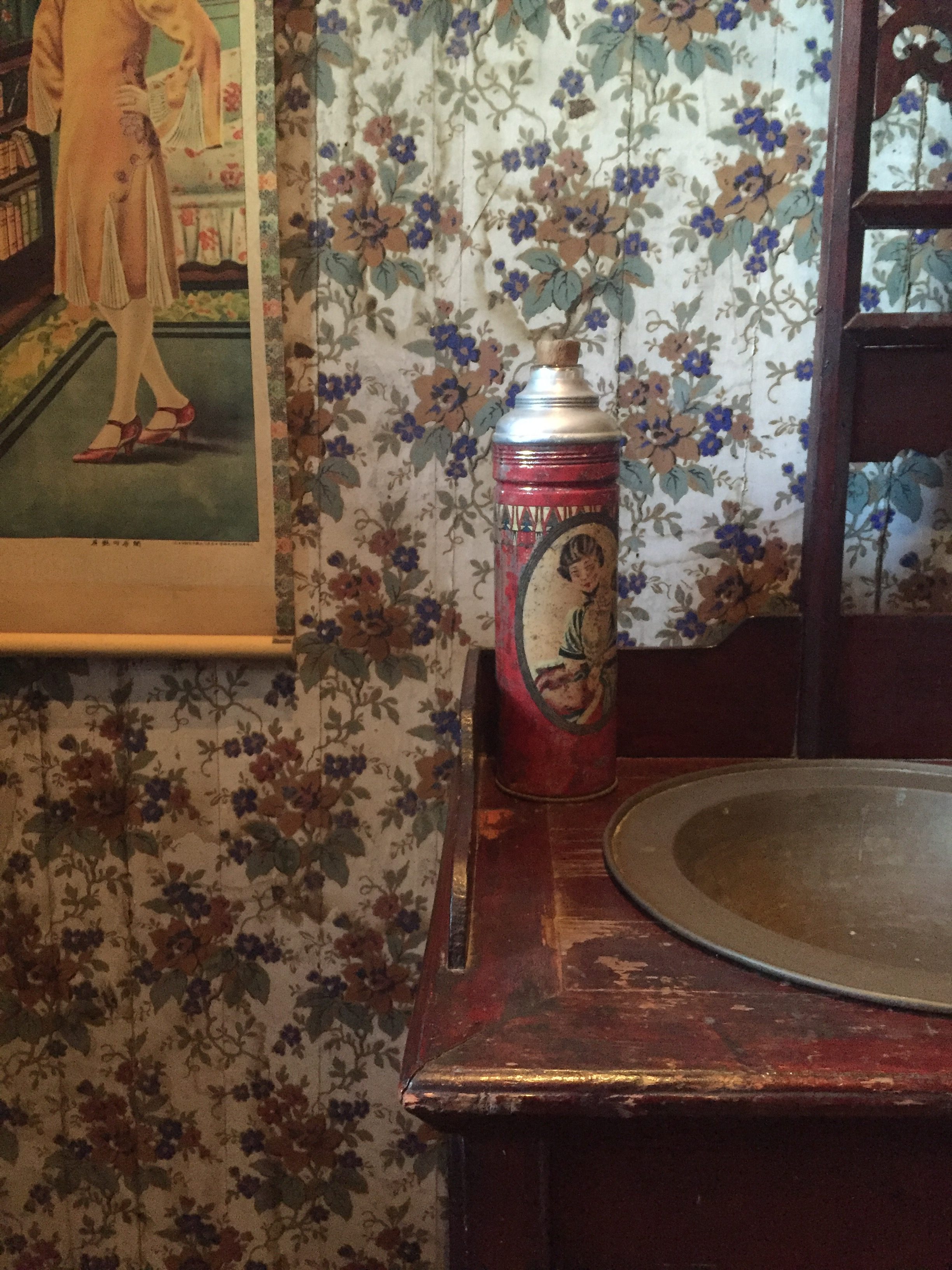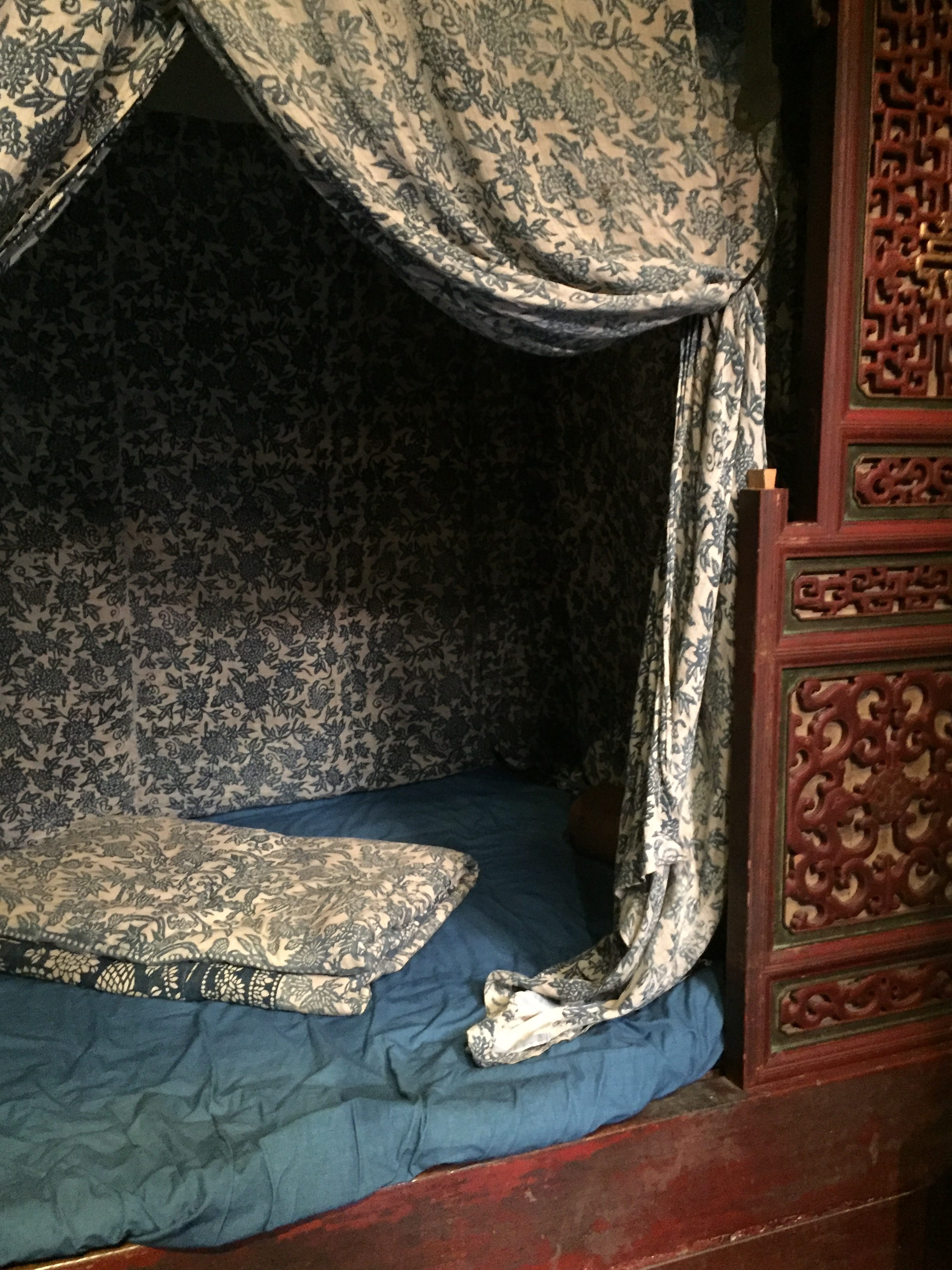A Wedding in Salem and a Chance to Visit Yin Yu Tang
Four weeks ago, my longtime partner Jon and I got married at City Hall in Salem, Massachusetts. We eloped! Since we are both extraordinarily busy with our material-culture pursuits right now—he’s a conservation technician at both the Philadelphia Museum of Art and the Penn Museum, and I’m a first year WPAMC fellow—we decided that we wanted a quiet wedding alone together in a place that we love. Salem is an ideal spot for people who love old things. We spent the weekend walking around old graveyards, peering into the windows of Federal mansions, and shopping at junk shops run by witches. I’m also a vintage clothing dealer, so before we left home, I took an antique lace dress and a wax blossom bridal crown from the storage racks of my shop. We stayed in Gloucester at an airbnb, a little 1930s stone cottage that was once the forge on a farm estate. It was all spur-of-the-moment and somehow perfect.
Image: Nov. 6th, 2017. Jon and I used my iphone to take our own wedding picture, which was inspired by 1910s wedding photos.
Wedding aside, maybe the best part of spending a weekend in Salem is getting to go to the Peabody Essex Museum. Its collection of Chinese export objects is unparalleled, and it has a wonderful gallery of early American furniture (for those of us who haven’t gotten enough at Winterthur.) Best of all, though, is Yin Yu Tang, the Chinese house inside PEM. Of all the interiors I’ve stepped into over the course of my life-long love of house tours, this is the most exquisite I’ve ever experienced. I relish every chance I get to visit this beautiful house, and this weekend was no exception.
Let me try to evoke the experience of Yin Yu Tang for those who have never visited it. The house was built in the Anhui province of China at the turn of the 19th century and was the home of a well-to-do merchant family, the Huangs, who sold the house to PEM in the 1990s. The building was then moved across the world to its current location in Salem. It is a complete house within a museum: to get to it, you go to the atrium of the Peabody Essex and pass through some glass doors, realizing that you have unexpectedly stepped outside. A bamboo-lined path leads you to a very tall lime white wall with a heavy wooden door in it. Beyond the door is a space that was once in China.
Inside the house, a dark wood construction contrasts with the fresh air of a central courtyard, the “skywell,” whose centerpiece is a rectangular koi pool. The rooms around this skywell are all small and dark, walled with lacy wooden lattice screens. On the ground floor there is first a gathering room, home to the altar to the ancestors, laid on the day of my visit with some incense and red-painted tins of tea. An object that looks like a barrel is revealed by the audio guide to be a “child minder,” a stand for swaddled infants.
Image: Detail of wooden latticework at Yin Yu Tang
High up in one of the corners of the altar room sits a small, pastel pink plastic loudspeaker. In this dark, hushed sanctuary of antique carved wood, this speaker offers a sudden and surprising aesthetic: to my Western, 1980s-born eye, it reads as cupcake frosting, Lisa Frank, Miami. The audio speaker in your hand tells you that this is a Communist Party loudspeaker, required in all electrified homes in the People’s Republic of China.
The incredible thing about Yin Yu Tang, a visitor soon realizes, is that when you’re inside it, you’re experiencing the material culture of many different periods at once. You have not merely been transported to 1801 but also to 1901 and to 1981—to a space that contained nearly the entire 19th and 20th centuries of a family’s existence. Eight generations of Huangs lived here. One of the sixteen small, rectangular bedrooms feels nearly half filled with an enclosed 19th-century red lacquer bed, draped with beautifully worn indigo-printed cotton drapery that has been patched with a different blue fabric in a few places. There are 1920s and 1930s pinups on the wallpaper, which is reminiscent of a colonial american chintz. On the desk is a red thermos with the scratched image of a lady on the front
 Image: Detail of a bedroom in Yin Yu Tang. A scratched red thermos sits on a washbasin. Behind is a floral wallpapered wall with a 1920s Chinese pinup poster hanging on it.
Image: Detail of a bedroom in Yin Yu Tang. A scratched red thermos sits on a washbasin. Behind is a floral wallpapered wall with a 1920s Chinese pinup poster hanging on it.
Image: A covered bed is hung with floral indigo printed cotton drapery.
This mixing of an extended family’s visibly used artifacts offers a remarkable interior beauty. Yin Yu Tag suggests something that I’ve never felt before while on a historic house tour: a sense that its space exists as a function of time rather than outside of time. In her book on the house, curator Nancy Berliner emphasizes the archicultural approach to the presentation of historic interiors, defining archiculture as “the culture inherent in the creation, the use, the decoration and the history of an architectural space.” In light of archiculture, the mission of a historic house museum becomes not simply preservation but also a reintegration of sorts. Under this model, a historic space can teach us how to live with the old and how to reuse what was left to us by our ancestors.
Yin Yu Tang has made me understand that when we as historians, collectors and appreciators allow cultural artifacts and spaces from the past and present to coexist with each other, we not only contextualize them for the contemporary viewer, but we also recognize their authentic natures. Objects have lives only in the context of the living. Yin Yu Tang is so inspiring to me because it is the expression of a live material culture, a culture which makes use and reuse of things, a study of a past which coexists with the present.
Looking back to my wedding weekend, I think that this same spirit of coexistence—the spirit that is so strong at Yin Yu Tang, and in Salem in general—was with us when my new husband and I used a smartphone to photograph ourselves in the style of couples who wed a hundred years before us.
Image: Studio Photo of a Chinese Wedding Couple, c.1910, Lee Brothers Studio Collection, Courtesy of National Archives of Singapore
By: Kate Budzyn, WPAMC Class of 2019





Leave a Reply